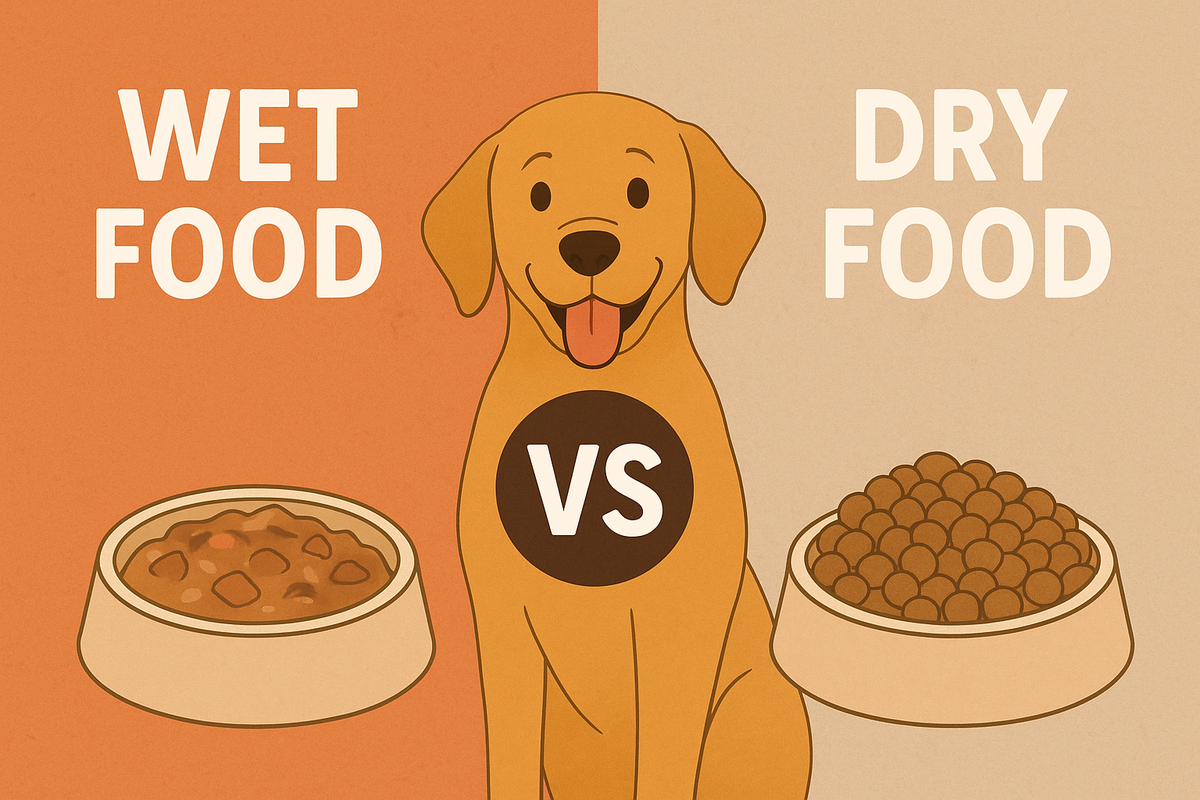
Wet Food vs Dry Food for Dogs: Which is Better for Your Pet?
|
|
Time to read 4 min
|
|
Time to read 4 min
Table of contents
Choosing the right food for your dog is one of the most important decisions you can make as a pet owner. With a variety of options available in the market, pet parents often find themselves confused between wet food and dry food for dogs. In this guide, we break down the differences, benefits, drawbacks, and nutritional aspects to help you make an informed choice for your furry friend.
Wet dog food, also known as canned or moist food, contains a high moisture content, usually between 70% and 85%. It is made with real meat, fish, or poultry combined with grains, vegetables, and other nutrients. Wet food is often preferred for its palatability and aroma, making it highly appealing to dogs, especially picky eaters.
High Palatability: Dogs are naturally attracted to the smell and taste of wet food.
Hydration Support: Wet food contains water, which helps keep dogs hydrated, especially those who drink less water.
Easy to Chew: Ideal for puppies, senior dogs, or dogs with dental issues.
High Protein Content: Premium wet foods like Nativfarm wet dog food are packed with essential proteins, supporting muscle growth and overall health.
Dry dog food, also known as kibble, contains less moisture (usually 8–12%) and has a long shelf life. It is easy to store, serve, and measure, making it a convenient option for dog owners.
Dental Health: The crunchiness of kibble helps reduce plaque and tartar buildup on teeth.
Convenience: Easy to store, measure, and serve without refrigeration.
Long Shelf Life: Dry dog food lasts longer than wet food, reducing wastage.
Cost-Effective: Generally more affordable than wet food for everyday feeding.
There is no universal answer—both wet and dry foods have their advantages. Choosing the right food depends on your dog’s age, health, and preferences.
Aspect
Wet Food
Dry Food
| Moisture Content | 70–85% | 8–12% |
| Palatability | High | Moderate |
| Dental Health | Less effective | Helps clean teeth |
| Shelf Life | Short (once opened) | Long |
| Cost | Higher | Lower |
| Ideal For | Puppies, senior dogs, picky eaters | Adult dogs, daily feeding, budget-conscious owners |
Conclusion: Wet food is great as a supplement or for occasional meals, while dry food is convenient for daily feeding. Combining both in a mixed diet can offer balanced nutrition and variety.
Yes, most dogs can eat dry dog food every day if it is nutritionally complete and balanced. Dry food is formulated to meet a dog’s daily requirements of protein, fats, vitamins, and minerals. However, some dogs may benefit from a mix of dry and wet food to improve hydration and taste variety.
Yes, preservatives are used in both wet and dry dog foods to ensure freshness and prevent spoilage. Common preservatives include:
Natural Preservatives: Vitamin E (Tocopherols), Vitamin C, Rosemary extract
Artificial Preservatives: BHA, BHT, Ethoxyquin (less commonly used in premium brands)
Premium brands like Nativfarm wet dog food use natural preservatives to maintain quality and ensure the food remains safe for your dog.
Many pet owners consider preparing home-cooked meals for dogs. While it can be nutritious, there are some challenges:
Balanced Nutrition: Homemade meals must include the right ratio of proteins, carbs, fats, vitamins, and minerals.
Time-Consuming: Preparing fresh meals every day requires effort and planning.
Consistency: Commercial foods ensure consistent nutrient content, which can be difficult to achieve at home.
Tip: For convenience and guaranteed nutrition, consider a combination—home-cooked meals occasionally and high-quality commercial food like Nativfarm wet food for everyday nutrition.
Dogs require a balanced diet rich in:
Proteins: For muscle development and repair
Fats: For energy and healthy skin
Carbohydrates: For energy
Vitamins & Minerals: For overall health, immune support, and bone strength
Water: Essential for hydration and organ function
Premium wet foods like Nativfarm wet dog food are formulated to meet these nutritional needs with high-quality ingredients such as chicken, fish, or grains.
1. Can I feed only wet food to my dog?
Yes, dogs can eat only wet food, but it may be costlier. Wet food is best combined with dry food for a balanced diet and dental health.
2. Is wet food healthier than dry food?
Not necessarily. Wet food provides hydration and taste, but dry food helps with dental care. Both can be healthy if nutritionally complete.
3. How often should I feed wet food?
1–2 times a day is sufficient. Wet food can be used as a meal supplement or occasional treat.
4. Can puppies eat dry food?
Yes, puppies can eat dry kibble specially formulated for their growth stage. Mixing with wet food can make it easier to chew.
5. Are preservatives harmful?
Natural preservatives used in premium dog food are safe. Avoid foods with excessive artificial preservatives.
6. Can I switch my dog from dry to wet food?
Yes, transition gradually over 5–7 days to prevent digestive issues.
Made with real meat, chicken, or fish
Free from artificial flavors and harmful preservatives
Nutritionally complete for all life stages
Perfect for picky eaters and senior dogs
Convenient ready-to-serve packs for busy pet parents
Both wet and dry foods have their advantages. For a balanced diet, consider a combination of dry food for everyday meals and Nativfarm wet food for variety and hydration. Always choose high-quality, nutrient-rich food to ensure your dog lives a happy, healthy, and long life.